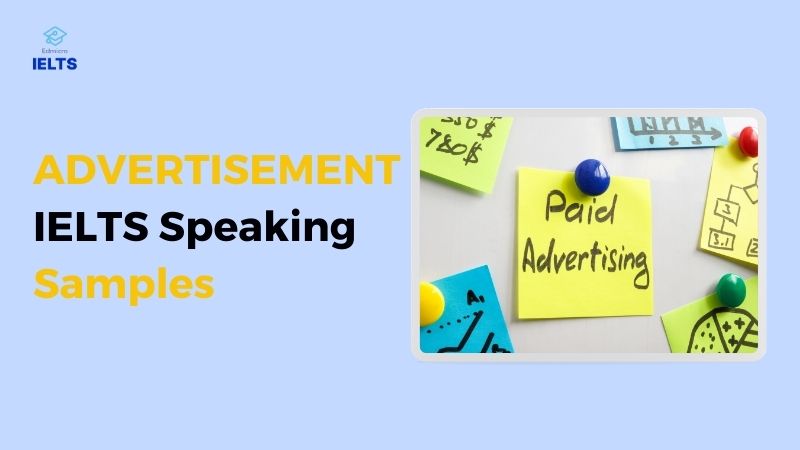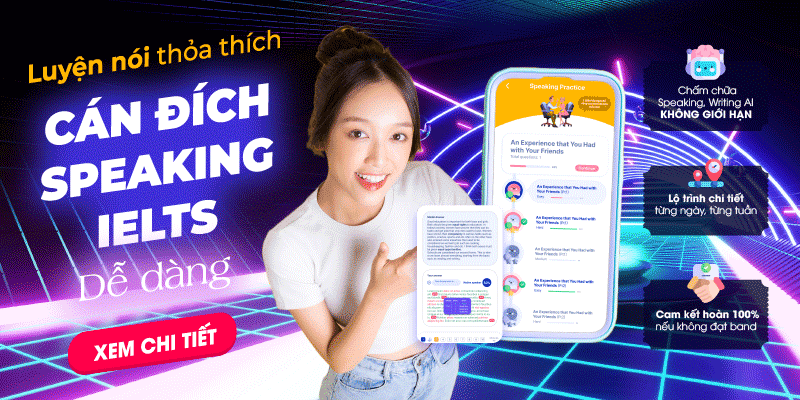Advertisement IELTS Speaking là một chủ đề có độ khó cao trong bài thi nói. Để hiểu về cách triển khai chủ đề này cũng như học thêm từ mới về Advertisement, hãy cùng Edmicro theo dõi bài viết dưới đây nhé.
Triển khai bài nói Advertisement IELTS Speaking
Để triển khai bài nói chủ đề IELTS speaking advertisement hiệu quả, bạn có thể tham khảo cách triển khai sau:
Cách phát triển ý
Ý tưởng là gốc rễ cho bài thi nói. Nếu không có ý tưởng bạn sẽ bế tắc ngay từ bước đầu tiên. Nếu ý tưởng không tốt thì sẽ rất khó để có một bài IELTS Speaking hay.
Vậy làm thế nào để tìm ra ý tưởng và liên kết chúng hiệu quả trong bài IELTS Speaking Advertisement ?
- Bạn có thể phát triển ý tưởng thông qua trả lời các câu hỏi quen thuộc: What, Where, When, Who, How, Why. Đây là quy trình tư duy phổ biến giúp bạn không bao giờ vơi cạn ý tưởng và đảm bảo tính liên kết, sự mạch lạc trong suốt phần trình bày.
- Bạn cũng có thể hình thành ý thông qua suy luận tương phản, tương đồng.
- Trong bài thi nói Advertisement IELTS Speaking bạn cũng cần đưa thêm ví dụ thực tế để làm tăng sức thuyết phục cho các luận điểm.
Các mô hình bài nói phổ biến:
- Diễn dịch ( đưa ra luận điểm trước và dùng dẫn chứng để minh họa)
- Quy nạp (đưa ra dẫn chứng rồi đi tới kết luận)
- Tổng – phân – hợp ( đưa ra luận điểm – cung cấp dẫn chứng – nhắc lại, nâng cao luận điểm)
Từ vựng & collocations Advertisement IELTS Speaking
Từ vựng & collocations là hai yếu tố dễ thấy giúp nâng tầm bài nói chủ đề “Advertisement in IELTS Speaking”. Cùng điểm qua một số từ vựng & collocations có thể sử dụng trong bài nói Advertisement IELTS Speaking Part 1, Advertisement IELTS Speaking Part 2 và Advertisement IELTS Speaking Part 3.

Từ vựng IELTS Speaking Advertisement
- Flyer (n): tờ rơi
- Commercial (n): Quảng cáo
- Jingle (n): đoạn nhạc quảng cáo
- Pop-up (n): quảng cáo xuất hiện bất ngờ trên màn hình
- Billboard (n): biển quảng cáo
- Telemarketing (n): tiếp thị qua điện thoại
- Celebrity endorsement (n): Quảng cáo thông qua người nổi tiếng
- Catchphrase (n): câu khẩu hiệu
- Headlines (n): tiêu đề
- Sponsorship (n): sự tài trợ
- Branding (n): làm thương hiệu
- Features (n): những đặc trưng của thương hiệu
- Brand ambassador (n): đại sứ thương hiệu
- Target audience (n): khách hàng mục tiêu
- Potential customer (n): khách hàng tiềm năng
- Promotion (n): khuyến mại
- Prime time (n): giờ vàng
- Mailshot (n): quảng cáo qua đường bưu điện
- Franchise (n): nhượng quyền thương mại
- Persuasive (adj): có tính thuyết phục
- Manipulate (v): Lôi kéo, ảnh hưởng tới ai
- Subliminal (adj): kích thích tiềm thức
- Sensational (adj): giật gân
- Eye-catching (adj): hút mắt
- Catchy (adj): dễ nhớ
- Attention-grabbing (adj): thu hút sự chú ý
- Ubiquitous (adj): có ở khắp nơi
- Stimulate (v): kích thích
- Bombard (v): Tấn công tới tấp
Xem thêm: IELTS Speaking Part 3: Chủ Đề Thường Gặp Và Cách Trả Lời Chi Tiết Nhất
Collocations IELTS Speaking Advertisement
- to slash the prices of products: giảm giá sốc
- buy good impulsively: mua hàng một cách bốc đồng
- to be swayed by advertisements: bị dao động bởi quảng cáo
- a price war: cuộc chiến về giá
- be wary of something: thận trọng với cái gì
- low-budget marketing ideas: các ý tưởng tiếp thị ngân sách thấp
- to publish great content: xuất bản nội dung tuyệt vời
- to create instructional videos: tạo các video hướng dẫn
- to be out of your budget: nằm ngoài ngân sách của bạn
- to attract new customers: thu hút khách hàng mới
- to grow word of mouth referrals: phát triển các mạng lưới giới thiệu truyền miệng
- to get traffic to a web page: có được lưu lượng truy cập vào một trang web
- pay-per-click ads: quảng cáo trả phí cho mỗi lần người dùng nhấp chuột vào link quảng cáo
- to increase brand awareness: tăng nhận thức về thương hiệu
- advertising campaigns: các chiến dịch quảng cáo
- newly-launched products: các sản phẩm mới ra mắt
- to set a specific budget over time: để đặt ngân sách cụ thể theo thời gian
- to stay up to date with …: cập nhật …
- to test a campaign: kiểm tra một chiến dịch (xem nó chạy tốt hay không)
- television commercials: Quảng cáo truyền hình
- to track the success of your ad: theo dõi sự thành công của quảng cáo của bạn
- a click-through rate: tỷ lệ nhấp chuột (vào link quảng cáo của bạn)
- to be targeted at the right customer: nhắm đúng khách hàng
- to reach large numbers of …: tiếp một số lượng lớn …
- a powerful advertising tool: một công cụ quảng cáo quyền lực
- to reach … within seconds: tiếp cận … trong vòng vài giây
- to be placed at the side of the screen: được đặt ở góc màn hình
- a traditional method of advertising: một phương pháp quảng cáo truyền thống
- to design eye-catching adverts: thiết kế quảng cáo bắt mắt
- outdated information: thông tin lỗi thời
- to promote temporary sales: thúc đẩy doanh số tạm thời
- to inform past customers of promotions: thông báo cho khách hàng trước đây về các chương trình khuyến mãi
- to bring new and returning customers: mang lại khách hàng mới và khách hàng cũ
- to be carefully researched and planned: được nghiên cứu và lên kế hoạch kỹ lưỡng
Sample Advertisement IELTS Speaking
Dưới đây là tổng hợp các câu trả lời mẫu cho IELTS Speaking Part 1 Advertisement, IELTS Speaking Part 2 Advertisement và IELTS Speaking Part 3 Advertisement.

Part 1
1. Are you interested in watching TV advertisements or internet advertisements?
I’m more interested in internet advertisements than TV advertisements. With the internet, advertisements are often more personalized and relevant to my interests, and I have the flexibility to choose when and what to engage with. TV advertisements, on the other hand, can be repetitive and less tailored to individual preferences. So, I find internet advertisements to be more engaging and informative.
Dịch:
Tôi quan tâm đến quảng cáo trên internet hơn là quảng cáo trên TV. Trên internet, các quảng cáo thường được cá nhân hóa và phù hợp hơn với sở thích của tôi, đồng thời tôi có sự linh hoạt để chọn khi nào và nội dung gì để tương tác. Ngược lại, quảng cáo trên TV có thể lặp đi lặp lại và ít được điều chỉnh theo sở thích cá nhân. Vì vậy, tôi thấy quảng cáo trên internet thú vị và cung cấp nhiều thông tin hơn.
Từ vựng:
- personalize (v): cá nhân hóa
- be relevant to (adj): liên quan tới
- be tailored to sb (adj): được thiết kế riêng cho ai
2. Have you ever bought something because of its advertisement?
Yes, I have bought products because of their advertisements. Advertisements can be quite persuasive, especially if they highlight features or benefits that resonate with my needs and preferences. For example, I once purchased a new smartphone after seeing an advertisement that showcased its advanced camera technology, which was important to me as I enjoy photography
Dịch:
Vâng, tôi đã từng mua sản phẩm vì quảng cáo của chúng. Quảng cáo có thể khá thuyết phục, đặc biệt khi chúng làm nổi bật những tính năng hoặc lợi ích phù hợp với nhu cầu và sở thích của tôi. Ví dụ, tôi đã từng mua một chiếc điện thoại thông minh mới sau khi xem một quảng cáo giới thiệu công nghệ camera tiên tiến của nó, điều này rất quan trọng với tôi vì tôi thích nhiếp ảnh.
Từ vựng:
- resonate with (v): phù hợp với
3. Do you want to be shown in the advertisement?
No, I don’t particularly have a desire to be featured in advertisements. I value my privacy and prefer to keep a low profile in the public eye. While some people may find it exciting, I’m more comfortable staying behind the scenes.
Dịch:
Không, tôi không đặc biệt muốn xuất hiện trong quảng cáo. Tôi coi trọng quyền riêng tư và thích giữ mình ở mức độ khiêm tốn trước công chúng. Dù một số người có thể thấy việc đó thú vị, nhưng tôi cảm thấy thoải mái hơn khi ở phía sau hậu trường.
Từ vựng:
- keep a low profile: tránh sự chú ý từ người khác
- staying behind the scenes: kín tiếng, không ai biết
4. What kinds of advertisements do you dislike?
I dislike advertisements that are overly intrusive or manipulative. For example, I find pop-up ads on websites and mobile apps to be annoying, as they disrupt the user experience. I also dislike advertisements that use fear or guilt to persuade people to buy a product. I believe that advertisements should be informative and transparent rather than trying to manipulate emotions to make a sale.
Dịch:
Tôi không thích những quảng cáo quá xâm phạm hoặc mang tính thao túng. Ví dụ, tôi thấy các quảng cáo pop-up trên website và ứng dụng điện thoại rất khó chịu, vì chúng làm gián đoạn trải nghiệm người dùng. Tôi cũng không thích những quảng cáo dùng nỗi sợ hãi hay cảm giác tội lỗi để thuyết phục người ta mua sản phẩm. Tôi tin rằng quảng cáo nên mang tính thông tin và minh bạch, thay vì cố gắng thao túng cảm xúc để bán hàng.
Từ vựng:
- intrusive (adj): gây phiền, gián đoạn
- disrupt (v): gây gián đoạn
- transparent (adj): rõ ràng
- manipulate (v): thao túng
Xem thêm: IELTS Speaking Part 2: Tổng Hợp Chủ Đề Thường Gặp Và Bài Mẫu Chi Tiết Nhất
Part 2
Đề bài
Describe an advertisement you like.
You should say:
- what type of advertisement it is
- what product or service it advertises
- where and when you first saw it
- And explain why you like it and think that this advertisement is effective.
Bài mẫu 1
I’d like to describe an advertisement that I really like. It’s a heartwarming television commercial for a popular brand of mobile phones.
The advertisement is for the latest model of smartphones from a well-known tech company. I first saw it on TV during a primetime show a few months ago. The ad opens with a young girl, around 10 years old, who is gifted a brand new smartphone by her parents. She’s initially excited and captivated by the phone’s features. However, the story takes a heartwarming twist as the girl uses the smartphone to record precious family moments, like her younger sibling’s first steps, a family picnic, and even her parents’ anniversary celebration. The ad ends with a tagline that says, “Capturing the moments that matter.”
I like this advertisement for several reasons. Firstly, it is emotionally engaging. It tugs at the heartstrings and underscores the idea that technology can help us capture and preserve important moments in our lives. The use of a young girl as the central character makes it relatable and adds an element of innocence and sincerity.
Moreover, I find it effective because it conveys a powerful message about the product’s capabilities. It emphasizes the smartphone’s role in facilitating connectivity and memory preservation, which are essential features for many consumers.
In summary, this advertisement is one that I like because of its emotional appeal and the effective way it conveys the product’s attributes. It resonates with the audience on a personal level and makes the product seem not just functional but also deeply meaningful in our lives.
Dịch:
Tôi muốn mô tả một quảng cáo mà tôi thực sự thích. Đó là một quảng cáo truyền hình ấm lòng cho một thương hiệu điện thoại di động phổ biến.
Quảng cáo này giới thiệu mẫu smartphone mới nhất của một công ty công nghệ nổi tiếng. Tôi lần đầu tiên xem nó trên TV trong một chương trình giờ vàng vài tháng trước. Quảng cáo mở đầu với một cô bé khoảng 10 tuổi được bố mẹ tặng một chiếc smartphone mới tinh. Cô bé ban đầu rất hào hứng và bị cuốn hút bởi các tính năng của điện thoại. Tuy nhiên, câu chuyện trở nên ấm lòng khi cô bé sử dụng smartphone để ghi lại những khoảnh khắc quý giá của gia đình, như những bước đi đầu tiên của em nhỏ, một buổi picnic gia đình, và thậm chí là lễ kỷ niệm ngày cưới của bố mẹ. Quảng cáo kết thúc với slogan: “Ghi lại những khoảnh khắc quan trọng.”
Tôi thích quảng cáo này vì nhiều lý do. Trước hết, nó chạm đến cảm xúc. Nó kéo trái tim người xem và nhấn mạnh rằng công nghệ có thể giúp chúng ta ghi lại và lưu giữ những khoảnh khắc quan trọng trong cuộc sống. Việc sử dụng một cô bé làm nhân vật trung tâm khiến câu chuyện gần gũi và thêm phần hồn nhiên, chân thành.
Hơn nữa, tôi thấy quảng cáo này hiệu quả vì nó truyền tải một thông điệp mạnh mẽ về khả năng của sản phẩm. Nó nhấn mạnh vai trò của smartphone trong việc kết nối và lưu giữ ký ức, những tính năng thiết yếu đối với nhiều người tiêu dùng.
Tóm lại, đây là một quảng cáo mà tôi thích vì sức hút cảm xúc và cách truyền đạt hiệu quả các đặc tính của sản phẩm. Nó tạo sự đồng cảm với khán giả ở mức độ cá nhân và khiến sản phẩm không chỉ hữu dụng mà còn trở nên ý nghĩa sâu sắc trong cuộc sống của chúng ta.
Từ vựng:
- primetime (n): giờ vàng
- tug at the heartstring (idiom): gây xúc động
- underscore (v): nhấn mạnh
- facilitate (v): make something easier
- attribute (n): thuộc tính
- resonate with: cộng hưởng với
Bài mẫu 2
One advertisement that I really like is a commercial for Coca-Cola that I saw on television last year. This advertisement was part of a holiday campaign, promoting the idea of sharing happiness with family and friends during festive seasons.
The ad begins with a cozy scene in a small town where people are preparing for a holiday celebration. It features families decorating their homes, children playing in the snow, and neighbors exchanging warm greetings. Throughout the commercial, people are shown enjoying Coca-Cola together, raising their glasses and sharing joyful moments. The background music is cheerful and catchy, adding to the festive atmosphere.
What makes this advertisement special is its storytelling and emotional appeal. Unlike many other commercials that focus on the product itself, this one focuses on the feelings and experiences that the product can create. It makes viewers feel nostalgic, happy, and inspired to spend quality time with their loved ones. The visuals are also very appealing, with bright colors, smiles, and a sense of community that is easy to relate to.
I like this advertisement for several reasons. Firstly, it is very memorable because of its emotional impact. Every time I see it, I feel warm and cheerful, which is a positive experience. Secondly, it doesn’t feel like a typical commercial; instead, it tells a story that resonates with people from all ages. Lastly, it subtly reminds me of the importance of spending time with family and friends, which is a valuable message in our busy lives.
In conclusion, this Coca-Cola advertisement is not only effective in promoting the product but also leaves a lasting impression on viewers. It combines creativity, emotion, and visual appeal perfectly, making it one of my favorite advertisements of all time.
Dịch:
Một quảng cáo mà tôi rất thích là một quảng cáo của Coca-Cola mà tôi đã xem trên truyền hình vào năm ngoái. Quảng cáo này là một phần của chiến dịch mùa lễ hội, nhấn mạnh ý tưởng chia sẻ niềm vui với gia đình và bạn bè trong những dịp đặc biệt.
Quảng cáo bắt đầu với một cảnh ấm cúng tại một thị trấn nhỏ, nơi mọi người chuẩn bị cho lễ hội. Nó mô tả các gia đình trang trí nhà cửa, trẻ em chơi trong tuyết, và hàng xóm trao nhau những lời chào thân thiện. Suốt quảng cáo, mọi người được thấy thưởng thức Coca-Cola cùng nhau, nâng ly và chia sẻ những khoảnh khắc vui vẻ. Nhạc nền vui tươi và bắt tai, làm tăng thêm không khí lễ hội.
Điều đặc biệt của quảng cáo này là cách kể chuyện và khả năng tạo cảm xúc. Khác với nhiều quảng cáo khác chỉ tập trung vào sản phẩm, quảng cáo này nhấn mạnh cảm xúc và trải nghiệm mà sản phẩm mang lại. Nó khiến người xem cảm thấy hoài niệm, hạnh phúc và được truyền cảm hứng để dành thời gian chất lượng với những người thân yêu. Hình ảnh cũng rất hấp dẫn với màu sắc tươi sáng, nụ cười và tinh thần cộng đồng dễ đồng cảm.
Tôi thích quảng cáo này vì nhiều lý do. Thứ nhất, nó rất dễ nhớ nhờ tác động cảm xúc mạnh mẽ. Mỗi lần xem lại, tôi cảm thấy ấm áp và vui vẻ, mang lại trải nghiệm tích cực. Thứ hai, nó không giống một quảng cáo bình thường; thay vào đó, nó kể một câu chuyện chạm đến mọi lứa tuổi. Cuối cùng, nó khéo léo nhắc nhở tôi về tầm quan trọng của việc dành thời gian với gia đình và bạn bè, một thông điệp quý giá trong cuộc sống bận rộn.
Tóm lại, quảng cáo Coca-Cola này không chỉ hiệu quả trong việc quảng bá sản phẩm mà còn để lại ấn tượng lâu dài cho người xem. Nó kết hợp hoàn hảo giữa sáng tạo, cảm xúc và hình ảnh, trở thành một trong những quảng cáo yêu thích của tôi.
Part 3
1. How do advertisements influence children?
Advertisements can influence children by shaping their preferences, desires, and behavior. They can impact dietary choices, leisure activities, and even perpetuate gender stereotypes. In the digital age, they can also affect self-esteem and body image. It’s crucial for parents to be aware of these influences and promote media literacy and critical thinking.
Dịch:
Quảng cáo có thể ảnh hưởng đến trẻ em bằng cách hình thành sở thích, mong muốn và hành vi của các em. Chúng có thể tác động đến lựa chọn thực phẩm, các hoạt động giải trí, thậm chí duy trì các định kiến về giới. Trong thời đại kỹ thuật số, quảng cáo còn có thể ảnh hưởng đến lòng tự trọng và hình ảnh cơ thể của trẻ. Việc cha mẹ nhận thức được những tác động này và khuyến khích trẻ phát triển tư duy phản biện, cũng như khả năng hiểu biết về truyền thông là rất quan trọng.
Từ vựng:
- perpetuate (v): duy trì
- stereotype (n): khuôn mẫu, hình mẫu
- self-esteem (n): lòng tự tôn
- media literacy (n): sự thông hiểu truyền thông
2. Should advertising aim at kids be prohibited?
The question of whether advertising aimed at kids should be prohibited is a matter of debate. Advocates of prohibition argue that children can be easily influenced and may not understand the persuasive intent of ads, while opponents believe that advertising can be educational and entertaining. Stricter regulations could provide a balanced approach, prioritizing children’s well-being while allowing responsible advertising.
Dịch:
Vấn đề liệu quảng cáo hướng đến trẻ em có nên bị cấm hay không là một chủ đề đang tranh luận. Những người ủng hộ lệnh cấm cho rằng trẻ em dễ bị ảnh hưởng và có thể không hiểu được mục đích thuyết phục của quảng cáo, trong khi những người phản đối tin rằng quảng cáo có thể mang tính giáo dục và giải trí. Việc áp dụng các quy định nghiêm ngặt hơn có thể là một cách tiếp cận cân bằng, vừa ưu tiên sự an toàn và lợi ích của trẻ em, vừa cho phép quảng cáo được thực hiện một cách có trách nhiệm.
Từ vựng:
- Advocate (n): người ủng hộ
- intent (n): ý định
- opponents (n): người phản đối
Edmicro vừa tổng hợp cho bạn những mẫu câu trả lời cho bài thi Advertisement IELTS Speaking. Hy vọng bài viết đã cung cấp cho bạn những gợi ý để bạn hoàn thiện thêm bài nói của mình.
Xem thêm











